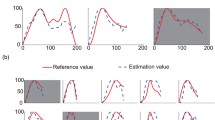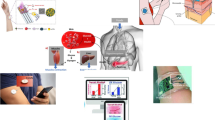Abstract
Non-invasive continuous glucose monitoring (NI-CGM) sensors are still at an early stage of development, but, in the near future, they could become particularly appealing in diabetes management. Solianis Monitoring AG (Zurich, Switzerland) has proposed an approach for NI-CGM based on a multi-sensor concept, embedding primarily dielectric spectroscopy and optical sensors. This concept requires a mathematical model able to estimate glucose levels from the 150 channels directly measured through the Multisensor. A static multivariate linear regression model (with order and parameters common to the entire population of subjects) was proposed for such a scope (Caduff et al., Biosens Bioelectron 26:3794–3800, 2011). The aim of this work is to evaluate the accuracy in the estimation of glucose levels and trends that the NI-CGM Multisensor platform can achieve by exploiting different techniques for model identification, namely, ordinary least squares, subset variable selection, partial least squares and least absolute shrinkage and selection operator (LASSO). Data collected in human beings monitored for a total of 45 study days were used for model identification and model test. Several metrics of standard use in the diabetes scientific community to measure point and clinical accuracy of glucose sensors were used to assess the models. Results indicate that the LASSO technique is superior to the others shrinking many channel weights to zero thus leading to smoother glucose profiles and resulting in a more robust model to possible artifacts in the Multisensor data. Although, as expected, the performance of the NI-CGM system with the LASSO model is not yet comparable with that of enzyme-based needle glucose sensors, glucose trends are satisfactorily estimated. Considering the non-invasive nature of the multi-sensor platform, this result can have an immediate impact in the current clinical practice, e.g., to integrate sparse self-monitoring of blood glucose data with an indication of the glucose trend to aid the diabetic patient in dealing with, or even preventing in the short time scale, the threats of critical events such as hypoglycaemia.






Similar content being viewed by others
References
Abu-Rmileh A, Garcia-Gabin W, Zambrano D (2010) A robust sliding mode controller with internal model for closed-loop artificial pancreas. Med Biol Eng Comput 48:1191–1201
Arnold MA, Small GW (2005) Noninvasive glucose sensing. Anal Chem 77:5429–5439
Bequette BW (2005) A critical assessment of algorithms and challenges in the development of a closed-loop artificial pancreas. Diabetes Technol Ther 7:28–47
Bode BW, Battelino T (2010) Continuous glucose monitoring. Int J Clin Pract Suppl 166:11–15
Burattini R, Morettini M, Di Nardo F, Boemi M (2011) Dynamics of insulin action in hypertension: assessment from minimal model interpretation of intravenous glucose tolerance test data. Med Biol Eng Comput 49:831–841
Caduff A, Dewarrat F, Talary M, Stalder G, Heinemann L, Feldman Y (2006) Non-invasive glucose monitoring in patients with diabetes: a novel system based on impedance spectroscopy. Biosens Bioelectron 22:598–604
Caduff A, Talary MS, Mueller M, Dewarrat F, Klisic J, Donath M, Heinemann L, Stahel WA (2009) Non-invasive glucose monitoring in patients with type 1 diabetes: a multisensor system combining sensors for dielectric and optical characterisation of skin. Biosens Bioelectron 24:2778–2784
Caduff A, Talary MS, Zakharov P (2010) Cutaneous blood perfusion as a perturbing factor for noninvasive glucose monitoring. Diabetes Technol Ther 12:1–9
Caduff A, Mueller M, Megej A, Dewarrat F, Suri RE, Klisic J, Donath M, Zakharov P, Schaub D, Stahel WA, Talary MS (2011) Characteristics of a multisensor system for non invasive glucose monitoring with external validation and prospective evaluation. Biosens Bioelectron 26:3794–3800
Clarke WL, Cox D, Gonder-Frederick LA, Carter W, Pohl SL (1987) Evaluating clinical accuracy of systems for self-blood glucose monitoring systems. Diabetes Care 10:622–628
Cobelli C, Toffolo GM, Dalla Man C, Campioni M, Denti P, Caumo A, Butler P, Rizza R (2007) Assessment of beta-cell function in humans, simultaneously with insulin sensitivity and hepatic extraction, from intravenous and oral glucose tests. Am J Physiol Endocrinol Metab 293:E1–E15
Cobelli C, Dalla Man C, Sparacino G, Magni L, De Nicolao G, Kovatchev BP (2009) Diabetes: models, signals, and control. IEEE Rev Biomed Eng 2:54–96
Cobelli C, Renard E, Kovatchev B (2011) Artificial pancreas: past, present, future. Diabetes 60:2672–2682
De Jong S (1993) SIMPLS: an alternative approach to partial least squares regression. Chemom Intell Lab Syst 18:251–263
Efron B, Hastie T, Johnstone I, Tibshirani R (2004) Least angle regression. Ann Stat 32:407–451
Fabietti PG, Canonico V, Federici MO, Benedetti MM, Sarti E (2006) Control oriented model of insulin and glucose dynamics in type 1 diabetics. Med Biol Eng Comput 44:69–78
Galvanin F, Barolo M, Macchietto S, Bezzo F (2011) Optimal design of clinical tests for the identification of physiological models of type 1 diabetes in the presence of model mismatch. Med Biol Eng Comput 49:263–277
Guerra S, Facchinetti A, Sparacino G, De Nicolao G, Cobelli C (2012) Enhancing the accuracy of subcutaneous glucose sensors: a real-time deconvolution-based approach. IEEE Trans Biomed Eng (Epub ahead of print)
Guerra S, Facchinetti A, Sparacino G, De Nicolao G, Cobelli C Method to recalibrate continuous glucose monitoring data on-line. International patent application, International Bureau of the World Intellectual Property Organization, Geneva. Official Filing number: PCT/IB2010/054947
Guerra S, Sparacino G, Facchinetti A, Schiavon M, Dalla Man C, Cobelli C (2011) A dynamic risk measure from continuous glucose monitoring data. Diabetes Technol Ther 13:843–852
Hastie TJ, Tibshirani R, Friedman JH (2009) The elements of statistical learning: data mining, inference, and prediction, 2nd edn. Springer, New York, pp 43–94, 219–257
Hovorka R (2008) The future of continuous glucose monitoring: closed loop. Curr Diabetes Rev 4:269–279
Kovatchev BP, Cox DJ, Gonder-Frederick LA, Clarke W (1997) Symmetrization of the blood glucose measurement scale and its applications. Diabetes Care 20:1655–1658
Kovatchev BP, Gonder-Frederick LA, Cox DJ, Clarke WL (2004) Evaluating the accuracy of continuous glucose-monitoring sensors. Diabetes Care 27:1922–1928
Kovatchev B, Anderson S, Heinemann L, Clarke W (2008) Comparison of the numerical and clinical accuracy of four continuous glucose monitors. Diabetes Care 31:1160–1164
Larin KV, Eledrisi MS, Motamedi M, Esenaliev RO (2002) Noninvasive blood glucose monitoring with optical coherence tomography: a pilot study in human subjects. Diabetes Care 25:2263–2267
Magni L, Raimondo DM, Dalla Man C, De Nicolao G, Kovatchev B, Cobelli C (2009) Model predictive control of glucose concentration in type I diabetic patients: an in silico trial. Biomed Signal Process 4:338–346
McGarraugh G (2009) The chemistry of commercial continuous glucose monitors. Diabetes Technol Ther 11:17–24
Mueller M, De Feo O, Talary MS, Stahel WA, Falco L, Caduff A (2011) Data processing for non-invasive continuous glucose monitoring with a multi-Sensor device. J Diabetes Sci Technol 5:694–702
Sparacino G, Zanderigo F, Corazza S, Maran A, Facchinetti A, Cobelli C (2007) Glucose concentration can be predicted ahead in time from continuous glucose monitoring sensor time-series. IEEE Trans Biomed Eng 54:931–937
Sparacino G, Facchinetti A, Cobelli C (2010) “Smart” continuous glucose monitoring sensors: on-line signal processing issues. Sensors 10:6751–6772
Tibshirani R (1994) Regression shrinkage and selection via the lasso. J R Stat Soc Ser B 58:267–288
Tikhonov AN, Arsenin VY (1977) Solutions of ill-posed problems. Winston/Wiley, Washington, DC
Tura A, Maran A, Pacini G (2007) Non-invasive glucose monitoring: assessment of technologies and devices according to quantitative criteria. Diabetes Res Clin Pract 77:16–40
Updike SJ, Hicks GP (1967) The enzyme electrode. Nature 214:986–988
Author information
Authors and Affiliations
Corresponding author
Rights and permissions
About this article
Cite this article
Zanon, M., Sparacino, G., Facchinetti, A. et al. Non-invasive continuous glucose monitoring: improved accuracy of point and trend estimates of the Multisensor system. Med Biol Eng Comput 50, 1047–1057 (2012). https://doi.org/10.1007/s11517-012-0932-6
Received:
Accepted:
Published:
Issue Date:
DOI: https://doi.org/10.1007/s11517-012-0932-6




